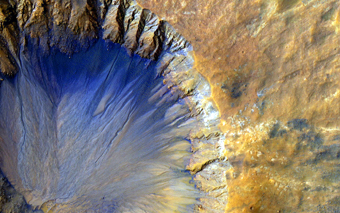
Youthful Martian Crater
| published June 10, 2015 |
By Keith H. Roberts Thursday Review contributor
Most craters and impact features on the Martian surface are old—as in hundreds of thousands, millions, even hundreds of millions of years in age. But the high resolution camera aboard NASA’s Mars Reconnaissance Orbiter captured this stunning, vividly toned photograph of a crater considered—in geological terms—relatively young.
The deep crater reveals it youth through the sharply-defined lines and ridges seen along its steep rim, and through the bright shades and hues seen in the soil and surface material of the ejecta blanket—the surface remnants of the dust and debris which landed after the violence of the impact subsided.
NASA geologists estimate the crater, which is located in the region called Sirenum Fossae, to be about 1 kilometer is diameter. The thin lines which flow from the upper rim of the crater down into its deep bowl—gullies and streams—may have been the result of water from melting ice. The relative “freshness” of the crater means that over time scientists on Earth can study changes—small or large—to the crater’s shape and contours in order to better understand how the landscape of Mars was formed.
This image is courtesy of NASA/JPL/University of Arizona.
Related Thursday Review articles:
Saturn’s Outward Calm; Thursday Review staff; Thursday Review; May 18, 2015.
